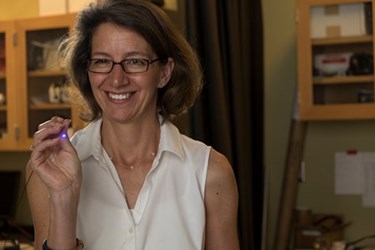Microendoscope Could Put an End To Unnecessary Esophageal Biopsies

A microendoscope designed at Rice University could help rule out malignancy in cases that might otherwise require a biopsy. An international clinical study has determined that the portable, low-cost device nearly doubles the sensitivity of esophageal screenings when used with a traditional endoscope.
Endoscopes currently used in cancer screenings can visualize a lesion and, in some cases, determine whether or not it is malignant. If the endoscopy is unsuccessful, a patient then requires a biopsy, in which surgeons resect a sample of the suspicious tissue to examine at a cellular level under a microscope. But what if the microscope could be threaded into the body instead?
This is the premise of Rice’s new device: a 1-mm-thick fiber-optic cable attaches to a traditional endoscope and transmits images to a high-powered fluorescence microscope, in real-time, for histological analysis. Endoscopists then can view the high-resolution image on a tablet or computer without having to remove tissue from the body. According to the researchers, the battery-operated device requires very little training to use.
“For patients, biopsies are stressful and sometimes painful,” said Rebecca Richards-Kortum, director of the Rice 360˚ Institute for Global Health Technologies, in a press release. “In addition, in low-resource settings, pathology costs frequently exceed endoscopy costs. So the microendoscope could both improve patient outcomes and provide a significant cost-saving advantage if used in conjunction with a traditional endoscope.”
Four hospitals and nearly a dozen institutions, comprising 147 patients in both the U.S. and China, participated in a clinical study examining the device’s efficacy. The study, published in Gastroenterology, investigated the sensitivity of a Lugol’s dye spray chromoendoscopy versus the low-cost, high-resolution microendoscope (HRME). Study results indicated that “136 biopsies could have been spared, and 55 patients spared any biopsy” when the HRME was incorporated into the screening.
Richards-Kortum said her team plans to adapt the technology to be used in other types of screenings for cervical, bladder, oral and colon cancers.
According to the World Health Organization (WHO), the number of new cancer cases diagnosed worldwide will increase from 14 million in 2012 to 22 million by 2032. A report from the American Cancer Society estimated that the direct costs of treating cancer globally represented 1.5 percent of the world’s gross domestic product (GDP).
